Log in
Search
Latest topics
» Landing-gear tipsby roddie Today at 6:17 pm
» Roger Harris revisited
by TD ABUSER Today at 2:13 pm
» Tee Dee .020 combat model
by Ken Cook Today at 1:41 pm
» Retail price mark-up.. how much is enough?
by Ken Cook Today at 1:37 pm
» Happy 77th birthday Andrew!
by getback Today at 11:52 am
» My latest doodle...
by roddie Today at 10:43 am
» My N-1R build log
by GallopingGhostler Yesterday at 3:04 pm
» Chocolate chip cookie dough.........
by roddie Yesterday at 1:13 pm
» Purchased the last of any bult engines from Ken Enya
by sosam117 Yesterday at 11:32 am
» Free Flight Radio Assist
by rdw777 Yesterday at 9:24 am
» Funny what you find when you go looking
by rsv1cox Wed Nov 20, 2024 3:21 pm
» Cox NaBOO - Just in time for Halloween
by rsv1cox Tue Nov 19, 2024 6:35 pm
Cox Engine of The Month
Green vent..
Page 1 of 1
 Green vent..
Green vent..
When we fill our vented fuel-tanks.. raw fuel leaks from the vent; as a signal that the tank is full. Correct?
Last edited by roddie on Tue Apr 11, 2023 8:32 am; edited 1 time in total (Reason for editing : some clarification..)
 Re: Green vent..
Re: Green vent..
roddie wrote:When we fill our vented fuel-tanks.. raw fuel leaks from the vent; as a signal that the tank is full. Correct?
Do you mean stunt tank or conventional (Babe Bee) tank?

Oldenginerod- Top Poster

- Posts : 4018
Join date : 2012-06-15
Age : 62
Location : Drouin, Victoria
 Re: Green vent..
Re: Green vent..
Well...not always. A couple of my backplates have the nipple with vent hole right next to it, that is, on the same side of the needle. So as fuel is being pushed in, air is being pushed up and out. The ensuing bubbling makes it tough to discern "full," or "just a mess."
What's worse is if I push hard on the hose, it can block the air vent. Then the tank pressurizes through the tank's pick-up tube, passed the jet, and dribbles out the air inlet.
To beat this, I keep a Tractor Supply needle/syringe so I can put the needle INSIDE the filler tube. This even works for my external run tanks.
My Golden Bee/Black Widow tanks are easy...one tube up, one tube down. A good seal between the filler tube and the fuel bottle/syringe will ensure a good, observable fill.
I hope this helps.
What's worse is if I push hard on the hose, it can block the air vent. Then the tank pressurizes through the tank's pick-up tube, passed the jet, and dribbles out the air inlet.
To beat this, I keep a Tractor Supply needle/syringe so I can put the needle INSIDE the filler tube. This even works for my external run tanks.
My Golden Bee/Black Widow tanks are easy...one tube up, one tube down. A good seal between the filler tube and the fuel bottle/syringe will ensure a good, observable fill.
I hope this helps.
_________________
Never enough time to build them all...always enough time to smash them all!
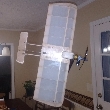
944_Jim- Diamond Member




Posts : 2022
Join date : 2017-02-08
Age : 59
Location : NE MS
 Fueling Cox engines
Fueling Cox engines
A hypodermic syringe with the point filed blunt works great for fueling these engines. Back in the 1970's I used to fly a Guillows Super Cub powered by a Pee Wee 0.020. 0.4cc using a 1cc syringe gave an engine run of around 30 seconds. I believe that a full Pee Wee tank held about 2cc of fuel.

706jim- Gold Member

- Posts : 472
Join date : 2013-11-29
 Re: Green vent..
Re: Green vent..
Thanks for your interest/replies guys. Please accept my apology for being M.I.A. for a few days. I'll elaborate a little more..
 Re: Green vent..
Re: Green vent..
Oldenginerod wrote:roddie wrote:When we fill our vented fuel-tanks.. raw fuel leaks from the vent; as a signal that the tank is full. Correct?
Do you mean stunt tank or conventional (Babe Bee) tank?
Actually Rod; "any tank" having a vent with an accessible "nipple" to which a short length of fuel line can be attached, during the filling/topping-off of the tank.
 Re: Green vent..
Re: Green vent..
944_Jim wrote:Well...not always. A couple of my backplates have the nipple with vent hole right next to it, that is, on the same side of the needle. So as fuel is being pushed in, air is being pushed up and out. The ensuing bubbling makes it tough to discern "full," or "just a mess."
What's worse is if I push hard on the hose, it can block the air vent. Then the tank pressurizes through the tank's pick-up tube, passed the jet, and dribbles out the air inlet.
To beat this, I keep a Tractor Supply needle/syringe so I can put the needle INSIDE the filler tube. This even works for my external run tanks.
My Golden Bee/Black Widow tanks are easy...one tube up, one tube down. A good seal between the filler tube and the fuel bottle/syringe will ensure a good, observable fill.
I hope this helps.
Yea.. those Cox "single-nipple" tank-backplates that you describe in your first paragraph wouldn't qualify for my Green vent application.
 Re: Green vent..
Re: Green vent..
We can either let our fuel run onto the ground once the tank fills.. or we can choose a more "Green" approach.
This idea is more applicable to "bench-running" but could also be applied at the field. A fuel "overflow reservoir" can be made from a small transparent vessel.. such as a plastic bottle for receiving a short length of fuel-line connected to the engine's tank-vent nipple. I'm using a clear plastic storage-tube similar in size/shape to a test-tube for use on my bench-run station.
See below photo...
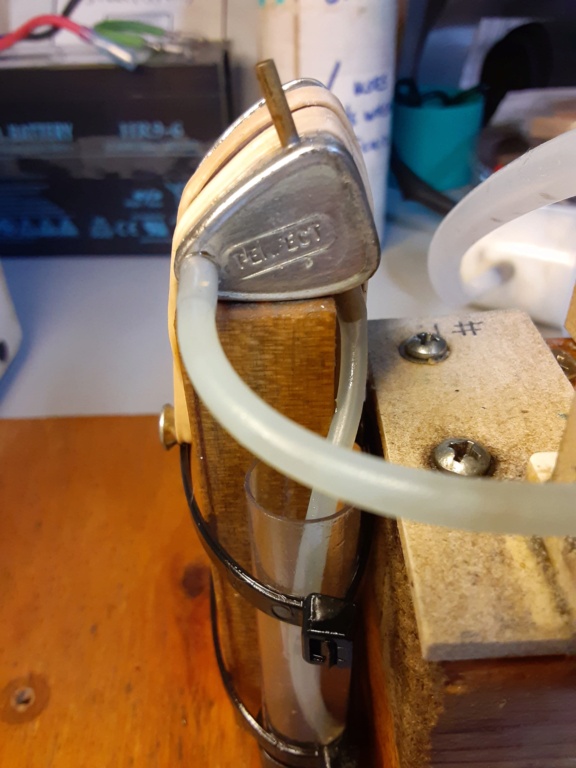
Below image shows the backside of my station.. and what I devised to mount a wedge-tank.
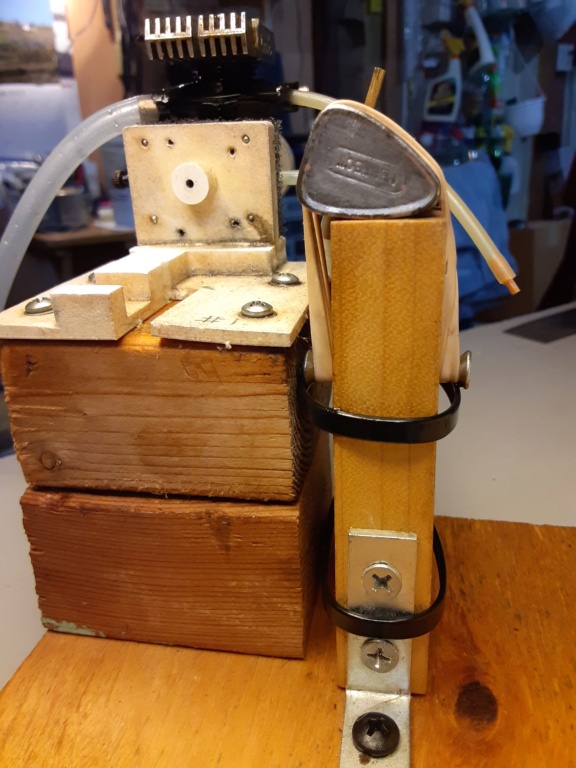
Incidentally; when done running the engine, the "vented fuel" can be evacuated from the overflow by simply applying "suction" to the tank's filler-tube with a bulb or syringe.
This idea is more applicable to "bench-running" but could also be applied at the field. A fuel "overflow reservoir" can be made from a small transparent vessel.. such as a plastic bottle for receiving a short length of fuel-line connected to the engine's tank-vent nipple. I'm using a clear plastic storage-tube similar in size/shape to a test-tube for use on my bench-run station.
See below photo...

Below image shows the backside of my station.. and what I devised to mount a wedge-tank.

Incidentally; when done running the engine, the "vented fuel" can be evacuated from the overflow by simply applying "suction" to the tank's filler-tube with a bulb or syringe.
 Not so green Jorge :lol:
Not so green Jorge :lol:
Back 30 or more years ago, we used to use clear vinyl tubing for fuel line. This was the stuff that got age hardened but when new, was flexible. It was also reasonably thin walled. The later silicon tubing has a thicker wall. It was this earlier tubing that the hole was offset to miss when filling the tank, IMO.944_Jim wrote:Well...not always. A couple of my backplates have the nipple with vent hole right next to it, that is, on the same side of the needle. So as fuel is being pushed in, air is being pushed up and out. The ensuing bubbling makes it tough to discern "full," or "just a mess." What's worse is if I push hard on the hose, it can block the air vent. Then the tank pressurizes through the tank's pick-up tube, passed the jet, and dribbles out the air inlet.
I don't know why Cox simply didn't place that hole on the other side of the needle valve, where the old duplicate fueling nipple was. There was an advantage to that other fueling nipple. It was easier to see when tank was full, because that nipple directed the fuel in an "aimed" stream, shooting up a half inch or more.

IMOroddie wrote:We can either let our fuel run onto the ground once the tank fills.. or we can choose a more "Green" approach.

The fuel evaporates so quickly after it falls, that in short order it is not there. Or, spread a tarp under where one is fueling, so it can be wiped up with a rag or paper towel.
As the late George Carlin used to say, The earth will do fine after we [the human race] are gone.

Please forgive me, @roddie for my little bit of foolishness here, please don't let me hinder you.

Carry on!






GallopingGhostler- Top Poster


Posts : 5724
Join date : 2013-07-13
Age : 70
Location : Clovis NM or NFL KC Chiefs
 Re: Green vent..
Re: Green vent..
As the late George Carlin used to say, The earth will do fine after we [the human race] are gone. lol!
As it did for the billions of years before we got here and hopefully it will recover after we leave. There was a TV series - Life after People - that I enjoyed and never missed a showing.
From Wikipedia.
Life After People is a television series on which scientists, mechanical engineers, and other experts speculate about what might become of planet Earth if humanity suddenly disappeared. The featured experts also talk about the impact of human absence on the environment and the vestiges of civilization thus left behind. The series was preceded by a two-hour special that aired on January 21, 2008, on the History Channel which served as a de facto pilot for the series that premiered April 21, 2009. The documentary and subsequent series were both narrated by James Lurie.
As it did for the billions of years before we got here and hopefully it will recover after we leave. There was a TV series - Life after People - that I enjoyed and never missed a showing.
From Wikipedia.
Life After People is a television series on which scientists, mechanical engineers, and other experts speculate about what might become of planet Earth if humanity suddenly disappeared. The featured experts also talk about the impact of human absence on the environment and the vestiges of civilization thus left behind. The series was preceded by a two-hour special that aired on January 21, 2008, on the History Channel which served as a de facto pilot for the series that premiered April 21, 2009. The documentary and subsequent series were both narrated by James Lurie.

rsv1cox- Top Poster




Posts : 11250
Join date : 2014-08-18
Location : West Virginia
 Re: Green vent..
Re: Green vent..
GallopingGhostler wrote:
IMOWith these small half-A tanks and manual fueling systems, the amount of fuel wasted is so small, less than an eigth of a teaspoon, that the amount of work to recirculate back to a sump or can is a bit of overkill, no?

The fuel evaporates so quickly after it falls, that in short order it is not there. Or, spread a tarp under where one is fueling, so it can be wiped up with a rag or paper towel.
As the late George Carlin used to say, The earth will do fine after we [the human race] are gone.
Please forgive me, @roddie for my little bit of foolishness here, please don't let me hinder you.
Carry on!





No worries George.. I've been on a quest to find ways of making our engines run cleaner.. as well as more quietly. This Green-vent-idea is part of that mindset.
Here's a photo showing my bench-run station with a slightly modified Babe Bee with one of my mufflers.
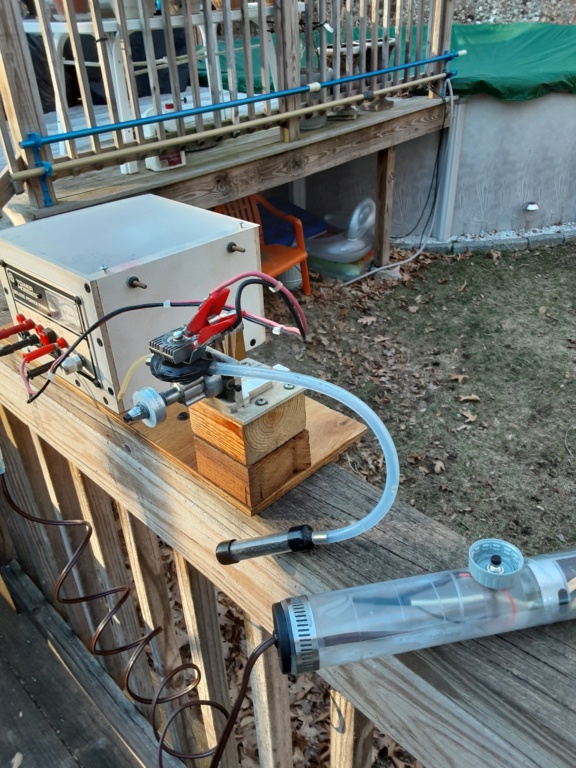
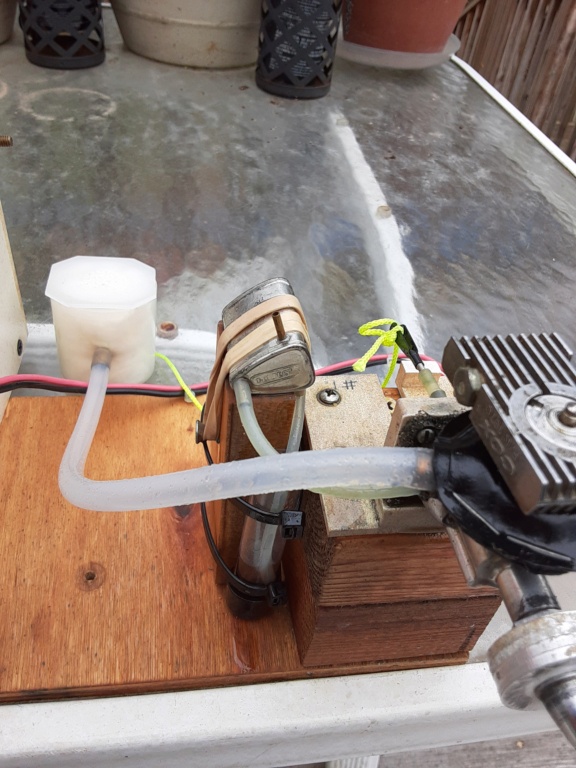
One of the muffler pipes (a spent .22 cal. LR shell-casing) has a piece of silicone tubing attached. I made-up a few different sumps or resonators to see how they will behave when the engine is running. IE; will they reduce oil-emissions and/or reduce noise-emissions further.. as compared to running my muffler alone.
 Green Vent-2024 overflow bottle
Green Vent-2024 overflow bottle
I was reminded of my Green Vent idea earlier today.. and made an overflow-capsule for "at the field" use. Basically a bottle with a hose and vented cap.
Materials; X1 plastic bottle .5oz. (15cc) capacity with screw cap, X1 small "Perfect" (brand) lead-out tube (flared brass tube) and X1 6" length of small (.062" ID) glow-fuel line.
Tools; a sharp "awl" (small.. preferably), a 3/32" twist-drill and a VSR cordless-drill.

The center-hole through the cap is the vent.. and is merely "pierced" using the awl.. (or alternately a "T" or push-pin)

The offset thru-hole in cap made with 3/32" twist-drill.

The lead-out guide fits thru the hole from inside the cap.

The awl helps to install the flared brass tube into the hole in the bottle-cap.. and also stabilizes it which helps when installing the fuel-tubing.


Shown connected to one of the backplate-nipples on my Pee Wee .020..

Shown connected to the wedge tank on the starboard engine of my P38..


Store it and use it, along with your syringe/fuel-bulb. How many cc's of fuel (on avg.).. spill out of tank-vents when fueling-up?
Materials; X1 plastic bottle .5oz. (15cc) capacity with screw cap, X1 small "Perfect" (brand) lead-out tube (flared brass tube) and X1 6" length of small (.062" ID) glow-fuel line.
Tools; a sharp "awl" (small.. preferably), a 3/32" twist-drill and a VSR cordless-drill.

The center-hole through the cap is the vent.. and is merely "pierced" using the awl.. (or alternately a "T" or push-pin)

The offset thru-hole in cap made with 3/32" twist-drill.

The lead-out guide fits thru the hole from inside the cap.

The awl helps to install the flared brass tube into the hole in the bottle-cap.. and also stabilizes it which helps when installing the fuel-tubing.


Shown connected to one of the backplate-nipples on my Pee Wee .020..

Shown connected to the wedge tank on the starboard engine of my P38..


Store it and use it, along with your syringe/fuel-bulb. How many cc's of fuel (on avg.).. spill out of tank-vents when fueling-up?
 Similar topics
Similar topics» The Green Green Grass of Home
» Best $2 I spent this year
» tee dee vent
» vent in my wedge tank
» What about a cox .049 engine endurance contest???
» Best $2 I spent this year
» tee dee vent
» vent in my wedge tank
» What about a cox .049 engine endurance contest???
Page 1 of 1
Permissions in this forum:
You cannot reply to topics in this forum

 Rules
Rules






